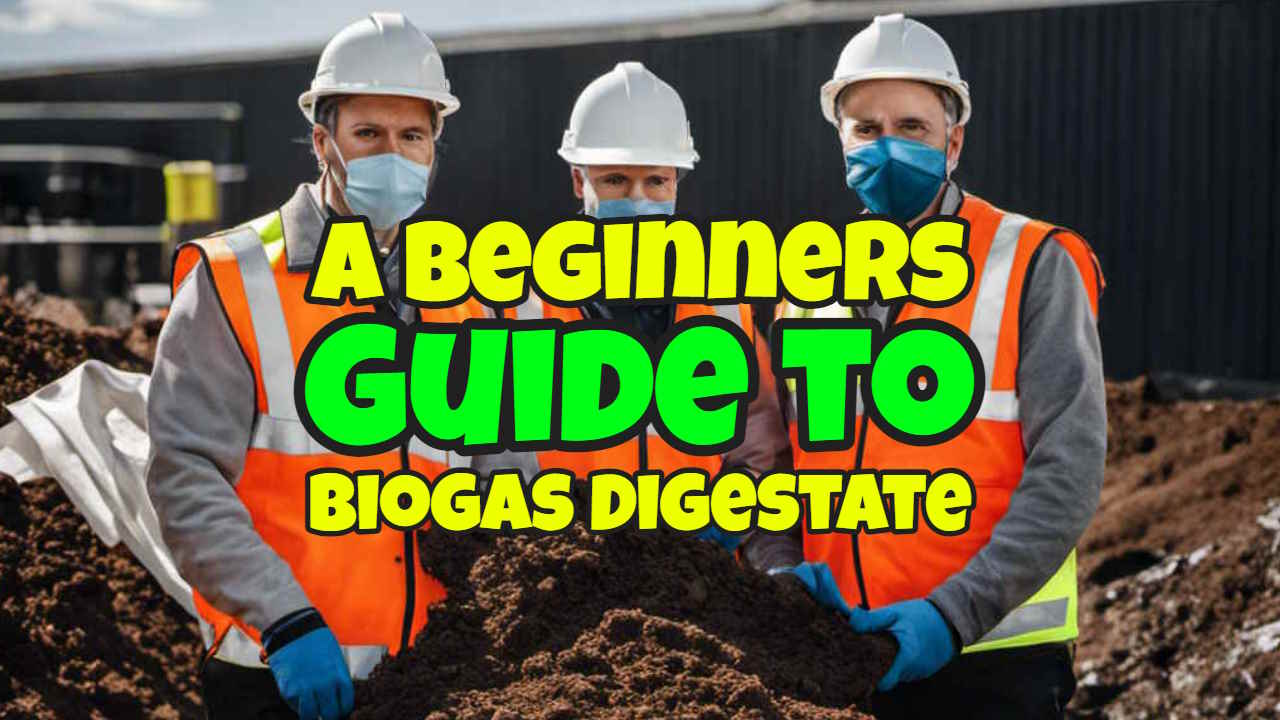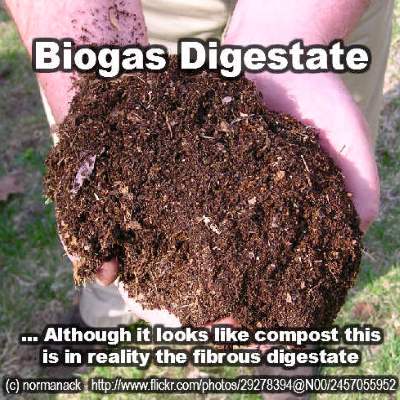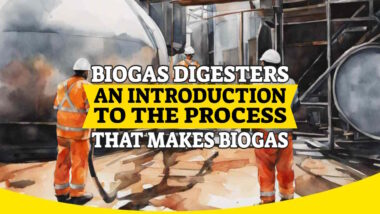As a guide to Biogas Digestate, we cannot do better to start with a definition. Biogas digestate is the material left over after the anaerobic digestion of an organic (carbon-based material) feedstock. The anaerobic digestion process produces two primary outputs.
These are digestate and biogas. Digestate leaves the digester tank as a mixture of water and solids. It flows out to drop to the ground, where water runs out freely from the fibrous solid content.
The Evolution of Digestate
Digestate is produced from the start of the reaction when the initial breakdown of the complex chemicals which were in each cell when alive, begins.
The cells are broken open during acidogenesis, and methanogenesis (the biogas/methane-making stage) and each stage has a different chemical character.
Digestate is technically not the same as compost. This confuses many people because it certainly resembles it both in its chemical and physical qualities.
Compost is produced from digestate by a further stage of aerobic digestion in which decomposition occurs by the action of aerobes.
As a guide to Biogas Digestate formation, aerobes include fungi and bacteria (germs!) which have the ability to break down the woody materials containing a high proportion of lignin and cellulose, to a higher extent.

Is Digestate a Liquid, a Solid or a Mixture of the Two (i.e. a Slurry)?
Yes. It's all 3!
So, digestate, in whatever form you see it, is either:
- mixed as a slurry as it comes out of the digester tank
- the solid portion which is the residue from the initial input (feed) material that went into the biogas digesters which the “germs” are unable to utilize
- the liquid part.
In 2 stage biogas digester systems, various types of digestate come from different digestion tanks, but in this discussion, we will only discuss the two already mentioned above.
 Digestate usually contains materials, such as lignin, that can not be broken down by the anaerobic micro-organisms. The digestate will usually contain a high level of ammonia that is phytotoxic (toxic to growing plants). In such cases, digestate would hinder the growth of plants if it was used as a soil-improving product, or worse.
Digestate usually contains materials, such as lignin, that can not be broken down by the anaerobic micro-organisms. The digestate will usually contain a high level of ammonia that is phytotoxic (toxic to growing plants). In such cases, digestate would hinder the growth of plants if it was used as a soil-improving product, or worse.
The “Maturation” or “Composting” Phase
From consideration of these 2 factors, a maturation or composting phase is normally applied to digestate after digestion and before it is used. In a composting pile, lignin and other products are readily available for destruction by aerobic bacteria, such as fungi. So, not only is the ammonia concentration reduced by subsequent composting but composting is also instrumental in reducing the remaining volume of the digestate material.
Throughout this maturation period, the ammonia will be oxidized into nitrates, enhancing the fertility of the product and making it a better soil improver. In dry anaerobic digestion processes, the composting stage may be the longest, when compared with other AD systems.
A Guide to Biogas Digestate Disposal
The biogas digester produces a solid and a liquid digestate in the slurry which flows out of the digester. the production of digestate is unavoidable so the procedure would not be sustainable unless an ecologically safe method of digestate disposal was available. Clearly, the aim of a biogas plant manager will always be to dispose of the output from his or her digesters in a way that meets environmental standards whilst also providing a “product” which can be sold (or at least given away) for beneficial use.
Thankfully, the application of digestate to land as a soil conditioner has been shown, in studies and by experience, to have a remarkable ability to prevent plant illness and even to induce resistance to infection, where none existed before. In this way, the application of digestate to land has a direct positive impact on soil-borne diseases, and an indirect impact because it also stimulates biological activity, as shown by scientific studies.
The Benefits of Digestate When Applied to Land
Acidogenic digestate, when applied to land and mixed into the soils, provides better wetness retention and a higher organic content for soils.
The liquid biogas digestate (methanogenic digestate) is rich in nutrients, leading to its obvious use as a fertiliser. Just how rich in nutrients a digestate is will always depend on the quality of the material being digested.
Possibly Hazardous Materials in Digestate
Levels of possibly hazardous materials (PTEs) need to be chemically examined.
As a guide to Biogas Digestate PTEs, the quality of the liquid digestate in respect of the mineral and metals content will be closely related to the quality of the initial feedstock. In most cases for agricultural AD plants, the levels of PTEs will be low.
In the case of wastes originating from the general market, the levels of PTEs may be greater and will certainly have to be taken into account when determining an appropriate end-use for the product. PTEs are highest in the Organic Fraction of Municipal Solid Waste (OFMSW – also known just as MOW (Municipal Organic Waste)).
The Qualities of Any Digestate
The qualities of any digestate produced in a biogas digester can be evaluated on three criteria, as follows:
- chemical,
- biological and
- physical aspects.
Chemical quality has to be thought about in terms of heavy metals and other inorganic contaminants, consistent natural substances and the material of macro elements such as Nitrogen, Phosphorous and Potassium. Depending upon their source, bio-wastes can also contain pathogens, which can result in the spreading of human, animal or plant diseases, if the risk of the presence of pathogens is not appropriately managed.
The “Publicly Available Specification” – PAS110
In the UK there is such a thing as a “Publicly Available Specification” (called PAS110) which governs the definition of digestate originating from the anaerobic digestion of source segregated eco-friendly products.
The specification sets out to ensure that all digested materials are of constant quality and “fit for purpose” when made into compost for commercial sales. If a biogas plant meets the requirement, its digestate will be regarded as having actually been completely recovered and to have stopped being waste, and once that happens it can be offered for sale with the name “Bio fertiliser”.
Anaerobic Digestion Followed by Composting
Many proprietory biogas digester systems incorporate both anaerobic digestion and composting. This might comprise a full anaerobic digestion phase first, followed by the maturation (composting) of the digestate.
In some, so-called “dry biogas digester” process designs, a partial anaerobic digestion phase can be caused through water that is percolated through the raw waste, dissolving the easily available sugars. This is then followed very often with the material being sent out to a windrow composting centre.
We hope this page has been a useful guide to Biogas Digestate.




